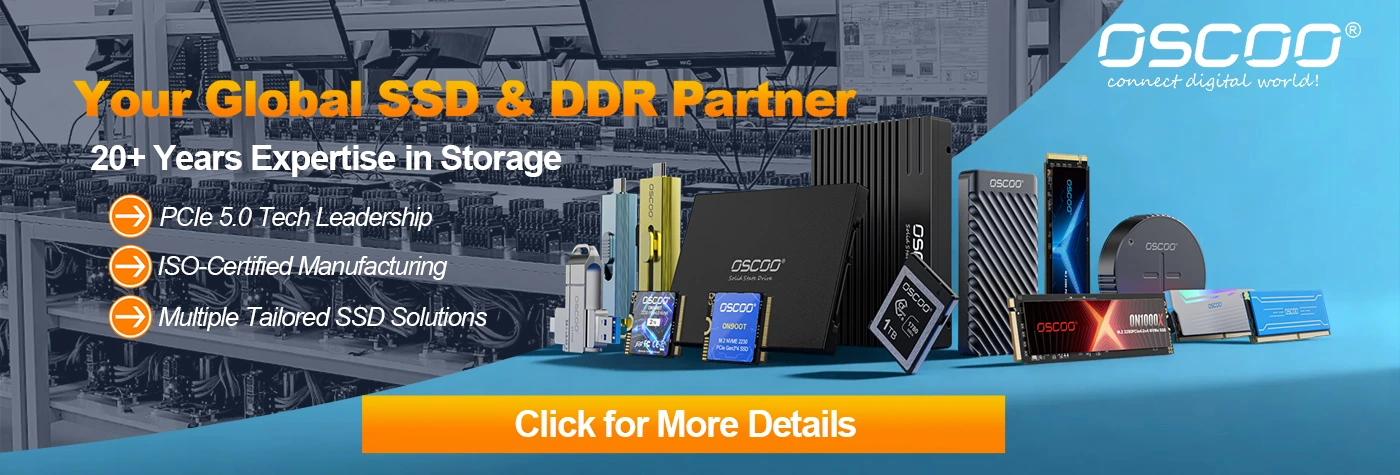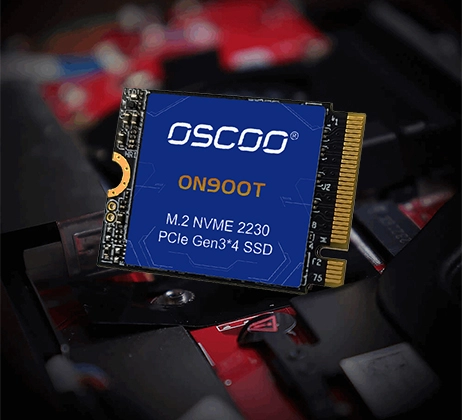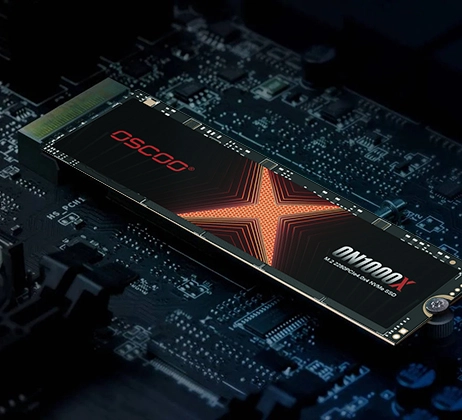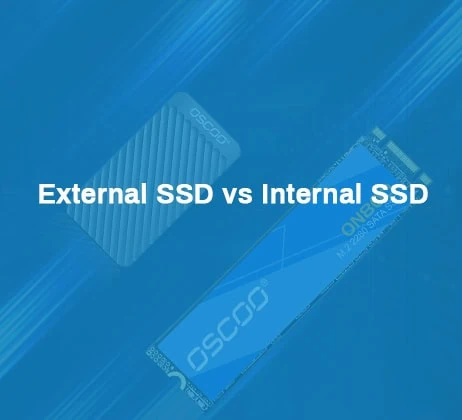Have you ever experienced this: your computer boots up slowly, opening an application takes forever, or it becomes sluggish and even prompts “low memory” when you have multiple browser tabs open? These frustrating performance issues are often closely related to two key components in your computer—SSD(固态硬盘) and RAM (Memory). Although they both sound related to “storage,” they play completely different roles, and many people easily confuse them. This article will explain the core differences between SSD and RAM in the most understandable way, how they work together, and help you make informed choices based on your needs.
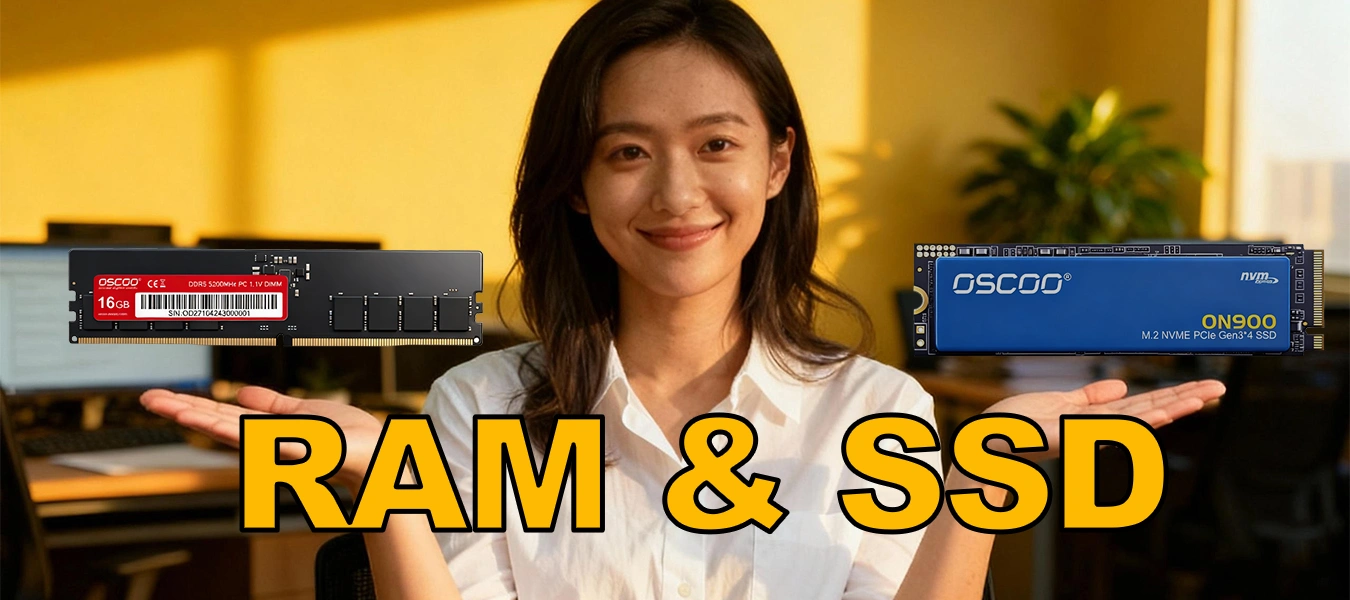
What is an SSD?
A 固态硬盘, abbreviated as SSD, is the primary long-term storage device in your computer. It’s like a digital filing cabinet, responsible for permanently storing your operating system, applications, personal documents, photos, videos, and all other files. Data stored on an SSD remains intact even when the computer is completely powered off.
What is an RAM?
Memory, with the full English name Random Access Memory, is commonly referred to as RAM. It is the computer’s short-term working memory, equivalent to the workbench the CPU uses to process data. Its role is to temporarily hold currently running programs and data that need immediate processing for the CPU to read at high speed. However, once power is cut off, all temporary contents on this workbench disappear immediately.
SSD vs. RAM: A Comprehensive Comparison
We can compare SSD and RAM in more depth from various dimensions. The core metaphor is that an SSD is like a warehouse, while RAM is like a workbench. The warehouse is used for long-term, bulk storage of all items, but retrieving things takes some time; the workbench has limited space, but the craftsman can immediately access any tools and materials on it for efficient work.
- Working Principle & Data Persistence: This is the most fundamental difference. RAM is a type of volatile memory; it requires constant power to maintain data. Once power is lost, all data on the workbench is instantly cleared. SSD, on the other hand, is a type of non-volatile memory; it uses flash memory technology to store data permanently. Your files remain safely stored inside regardless of whether the computer is powered on or not.
- Speed & Performance: This is where the performance gap is largest. RAM is extremely fast, with data transfer speeds measured in Gigabytes per second (GB/s). It’s the area where the CPU directly processes data, with very low latency. In comparison, while SSDs are much faster than traditional Hard Disk Drives (HDDs), their speeds are typically measured in Megabytes per second (MB/s) or GB/s, and they have higher latency. Simply put, RAM can be tens of times faster than an SSD. This huge speed difference dictates their division of labor.
- Capacity: Their capacity ranges are also completely different. As a warehouse, SSD capacities are typically large. For average users, options ranging from 256GB to several Terabytes (TB) are common, used for storing massive amounts of data. As a workbench, RAM capacity is much smaller. Current mainstream configurations usually range from 8GB to 64GB. It only needs to hold the most urgently needed data for current processing.
- Physical Form & Upgrade Method: Common SSD form factors include 2.5-inch drives or M.2 interface sticks (similar to a stick of gum). Installation and upgrades are relatively simple. RAM usually comes in the form of long “memory sticks” (DIMMs) that need to be inserted into dedicated narrow slots on the motherboard. Upgrading requires more attention to compatibility.
- Cost: If calculated per unit of capacity (e.g., price per 1GB), RAM is significantly more expensive than SSD. This is why we cannot use cheap SSDs to completely replace expensive but high-speed RAM.
How do SSD and RAM Work Together?
SSD and RAM are not substitutes for each other; they are partners with a clear division of labor that complement each other. To better understand how SSD and RAM cooperate, imagine a highly efficient office. In this metaphor, the Central Processing Unit (CPU) is the boss responsible for handling all tasks. The boss’s work efficiency largely depends on their office setup.
- Memory (RAM) is the boss’s desk. The size of this desk directly determines how much work the boss can handle simultaneously. A spacious desk allows the boss to spread out many files being processed, open spreadsheets, and reference materials, enabling quick switching between tasks with high efficiency. Conversely, a small desk means only one or two files can be out at a time. To handle a new task, files on the desk must be temporarily put away and then retrieved when needed again. This process is very time-consuming, leading to low efficiency for the boss—this is the cause of computer lag.
- The Solid State Drive (SSD) is the large filing cabinet in the corner of the office. All infrequently used files, historical archives, and project materials are filed away here. When the boss needs to work on a task not currently on the desk, like reviewing last year’s report, they need to get up, go to the filing cabinet, find the corresponding folder, and bring it back to the desk to examine.
This process of “getting up to fetch the file” is equivalent to the computer reading data from the SSD and loading it into RAM. The speed of the SSD determines how fast you can walk from the filing cabinet to the desk, while the size of the RAM determines how many files can fit on the desk at once. When you open a PC game or a large application like Photoshop, it’s like the boss needing all the materials for a large project. The CPU will direct the system to quickly move all necessary materials from the SSD filing cabinet to the RAM desk before high-speed processing can begin. If your desk (RAM) is too small and the project is too large, the boss has to constantly and frequently run back and forth between the filing cabinet and the desk just to swap a few files. The computer will exhibit severe lag. This phenomenon is technically called “memory swapping” and is a performance bottleneck.
Practical Advice & Buying Guide
- Everyday Office & Web Users (mainly handling documents, browsing the web, watching videos): These users have modest hardware requirements. 8GB of RAM can serve as a basic guarantee for system fluidity. However, if you need to open many browser tabs and multiple office applications simultaneously, upgrading to 16GB of RAM will significantly improve multitasking capability. For storage, a 256GB SSD is generally sufficient, but if you wish to store many photos, videos, or files, 512GB would be a more comfortable choice.
- Gamers: Current mainstream games have increasingly high demands on memory. 16GB has become the standard configuration. If the budget allows, opting for 32GB of RAM future-proofs the system for larger games in the coming years and better supports background tasks like game streaming and voice chat. SSDs greatly impact gaming experience. It is recommended to choose a high-speed NVMe protocol SSD with at least 512GB or 1TB capacity. This not only allows for installing more games but also significantly shortens game loading times, enhancing the overall gaming experience.
- Content Creators & Professionals, including video editors, 3D animators, and software developers: These workflows involve handling large files and parallel multitasking, requiring very high RAM capacity. 32GB of RAM is a starting configuration; for handling 4K video or complex projects, 64GB or more is needed to ensure smooth operation. For storage, a high-speed 1TB (or larger) NVMe SSD is recommended as the system and project drive for current work files and software. This can be paired with a large-capacity Hard Disk Drive (HDD) as an archive drive for backups and storing less frequently accessed project materials.
- Other Considerations: When making a purchase, besides capacity, pay attention to key parameters.
- For RAM, capacity is primary, but frequency (e.g., DDR4-3200) and timings (e.g., CL16) are also important. Higher frequency allows faster data transfer rates, and lower timings mean shorter latency. Also, using a dual-channel configuration (installing two identical RAM sticks) can significantly increase memory bandwidth.
- For SSDs, the interface type is crucial. SATA interface is slower, while M.2 interface NVMe SSDs are much faster and the preferred choice for modern computers. Read/write speed metrics are worth referencing but don’t overly pursue extreme numbers. Pay more attention to the TBW (Terabytes Written) parameter, which indicates the drive’s endurance and lifespan—higher is better.
When working with a limited budget and need to prioritize, follow this basic principle:
- If you often experience lag when running multiple programs simultaneously or handling large files, prioritize upgrading RAM capacity.
- If your computer is slow to boot, load software, or transfer files, then upgrading or adding an SSD will bring a more direct experience improvement.
- For older computers using traditional HDDs, replacing it with an SSD is the most cost-effective upgrade, offering an immediate and noticeable improvement in overall system performance.
常见问题
Q: Do I want more RAM or more SSD?
A: This depends entirely on the specific problem you are currently facing. If your computer becomes very sluggish when running multiple programs simultaneously or opening many browser tabs, or even prompts “low memory,” then upgrading your RAM capacity will give you the most direct improvement. Conversely, if your problems are slow boot times, long waits to open software, or frequently running out of storage space forcing you to delete files, then upgrading or adding a larger SSD is the correct choice.
Q: Will SSDs replace RAM?
A: No. This is determined by their fundamental technical characteristics. RAM’s speed is crucial for the CPU’s operation; it is far faster than SSDs and has extremely low latency. Furthermore, the volatile nature of RAM is a core part of its design, not a flaw, allowing the CPU to read and write data quickly and freely without worrying about permanent storage. SSDs focus on long-term, stable data storage. They are complementary, not substitutive.
Q: Do I need both SSD and RAM?
A: Yes, a modern computer must have both to function properly. They are like the computer’s long-term memory and short-term working memory; both are indispensable. Without an SSD, the computer has nowhere to install the operating system or store your personal files. Without RAM, the processor has nowhere to temporarily hold and quickly process running programs and data.
Q: Is RAM still faster than SSD?
A: Yes, and the speed gap remains enormous. Even the fastest consumer-grade SSDs available are far slower than contemporary RAM. RAM access latency is measured in nanoseconds, while SSD latency is measured in microseconds. This means RAM’s response time is thousands of times faster than an SSD’s. This speed difference is the fundamental reason they play different roles.
Q: How much RAM is enough?
A: This depends on your usage habits.For everyday office work, web browsing, and media consumption: 8GB is the entry-level guarantee, 16GB is very comfortable.For gamers: 16GB is the current mainstream choice, 32GB can provide headroom for future games and intensive multitasking.For professionals doing video editing, 3D rendering, virtualization, etc.: 32GB is a starting configuration, often requiring 64GB or more for smooth operation.
Q: Should I use SSD as RAM?
A: You absolutely should not manually attempt this. The operating system itself has a mechanism called Virtual Memory, which automatically allocates a portion of the disk space to act as emergency temporary RAM when physical RAM is low. However, this is a performance compromise, not an optimization. Because storage drives are much slower than RAM, frequent use of virtual memory causes severe system performance degradation and lag. Adding more physical RAM is the only correct solution to insufficient memory.
Q: What’s more important, RAM or storage?
A: This is the wrong question, as they affect computer performance in different ways. RAM capacity directly affects your ability to run multiple programs simultaneously and smoothly. Storage capacity and speed determine how much data you can store and how quickly you can open programs and files. A well-balanced computer requires both to be appropriately configured. Think of them as the computer’s “workspace” and “storage space”—both are crucial for productivity.
Q: What does 8GB RAM and 256GB SSD mean?
A: This means your computer has an 8GB “workbench.” This space determines how many applications and browser tabs you can have open simultaneously while maintaining smooth performance. The 256GB “warehouse” space determines how many programs you can install and how many photos, videos, and documents you can store in total. One determines how much you can do at once, the other determines how much stuff you can keep.
In summary, SSD and RAM play distinctly different yet complementary roles in a computer. The Solid State Drive is your private warehouse, responsible for safely and permanently keeping all your digital assets. The Memory (RAM) is your efficient work desk, determining whether you can handle multiple tasks simultaneously and smoothly. One handles external storage, the other handles internal processing; together they form the cornerstone of computer performance. When configuring or upgrading your computer, make a balanced choice based on your actual needs. If you seek faster response and loading times, invest in a good SSD. If you need to run more programs simultaneously without lag, then expanding your RAM capacity is the answer.

